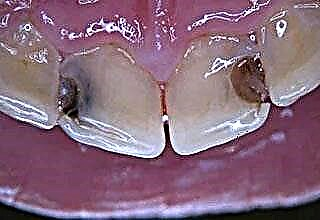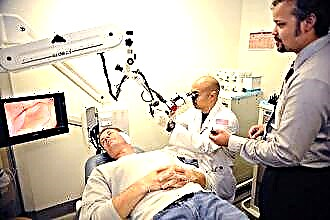 As a rule, single-chamber cavities are filled with serous or purulent exudate, as a result of which the cyst acquires a yellowish tint.
As a rule, single-chamber cavities are filled with serous or purulent exudate, as a result of which the cyst acquires a yellowish tint.
Large tumors partially or completely block the airways, which makes breathing difficult and leads to asphyxiation.
Untimely excision of cysts is fraught with the penetration of pathological secretions into the deeper tissues of the pharynx, which can lead to the development of sepsis, paratonsillar abscess, meningitis, etc.
Cyst - what is it?
A laryngeal cyst is a non-cancerous hollow neoplasm filled with pathological secretions. Benign tumors in the ENT organs in most cases refer to retention formations, which are formed when the lymphadenoid tissues are blocked and the walls of the acini are thickened. The density of the exudate contained in the cyst depends on the concentration of colloidal proteins: the more proteins, the denser the consistency of the pathological secretion.
Tumors are formed mainly on the palatine tonsils, laryngeal walls, vocal cords and epiglottis. In case of untimely diagnosis and therapy, cysts can significantly increase in size. Cystic formations with a diameter of more than 7 mm outwardly resemble vascular vesicles filled with yellow liquid.
For unknown reasons, in 80% of cases, benign tumors are localized on the left side of the larynx. Cysts are especially dangerous for children under 5 years of age. Due to the narrowness of the airways, even small tumors can provoke hypoxia (lack of oxygen), which negatively affects the physical and mental development of children. Over time, a bacterial flora develops in the cystic formations, as a result of which the serous exudate is replaced by purulent masses. The penetration of pus deep into the mucous membrane of the pharynx leads to inflammation of the epithelial and lymphoid tissues, which is fraught with the development of complications.
Classification of cysts
How to remove a cystic swelling in the throat? The principles of therapy depend on the site of localization, the type and size of the neoplasm. Despite the fact that cysts are characterized by slow expansive growth, an increase in their size leads to respiratory failure. In otolaryngology, there are several types of tumors that are localized in the ENT organs, namely:
- retentional - neoplasms that arise as a result of blockage of the laryngeal glands;
- laryngocele - air-filled formations that arise mainly in the area of the ventricles of the larynx;
- dermoid - thick-walled cysts filled with semi-liquid exudate;
- secondary - saccular neoplasms, which are formed during the degeneration of other types of benign tumors.
Congenital cysts occur as a result of abnormal embryonic development of the fetus. Irrational intake of hormonal drugs by a woman in the first trimester of pregnancy can provoke tumor growth.
Etiology
Why do cysts appear in the throat and larynx? The true causes of cystic formations are not known. Retention tumors are most often formed as a result of impaired drainage function of lymphoid tissues and ciliated epithelium. Subsequently, the glandular tissue of the throat is filled with macroscopic debris, which stimulates the formation of cysts.
There are several provoking factors, the influence of which increases the risk of developing saccular tumors in the ENT organs:
- tobacco smoking;
- insufficient hygiene of the oropharynx;
 bad ecology;
bad ecology;- work in hazardous industries;
- autoimmune disruptions;
- frequent relapses of infectious pathologies.
Treatment of pathology begins with the elimination of provoking factors and the use of anti-inflammatory drugs. However, for the complete disappearance of tumors, surgical intervention is necessary, during which the surgeon drains the pathological cavity and excises its walls, after which he disinfects the mucous membrane with an antiseptic solution.
Clinical manifestations
What symptoms indicate the formation of cysts in the throat area? Small neoplasms do not cause discomfort, therefore, pathology is diagnosed during a routine physical examination by an otolaryngologist. Clinical manifestations of pathology are largely determined by the location of the tumor.
In the case of a significant growth of the cyst, patients often complain of:
- labored breathing;
- wheezing in the throat;
- swelling in the neck;
- feeling of a lump in the throat;
- hoarseness of voice;
- discomfort when swallowing;
- aphonia.
Depending on the location of the tumor, the following characteristic symptoms may appear:
| Localization of cystic formations | Clinical manifestations |
|---|---|
| vocal folds | rapid breathing, hoarseness |
| laryngeal ventricles | dysphonia, laryngeal lump syndrome |
| epiglottis | moderate pain when swallowing, sensation of a foreign object in the throat, swelling of the neck |
| glottis | hoarseness and decreased timbre of the voice, intermittent cough |
| posterior pharyngeal wall | rapid breathing, slight pain when swallowing saliva |
Important! Cysts can become inflamed with the development of infectious ENT diseases.
Symptoms of body intoxication (hyperthermia, fever, headaches, sore throat) may indicate the development of an infection in the throat mucosa. If the contents of the cyst at the same time change color, most likely, bacteria are the causative agents of the disease. In this case, antimicrobial and antiphlogistic drugs are prescribed to the patient.
Drug therapy
What should be the treatment for cystic growths in the larynx? To stop the growth of a benign tumor and reduce the likelihood of suppuration, pharmacotherapy means. Conservative therapy is aimed at suppressing the activity of opportunistic microorganisms in the ENT organs, which can provoke inflammation of the cyst.
Important! Drug therapy does not lead to complete resorption of benign tumors, but reduces the risk of their infection.
To disinfect the oropharynx and reduce the number of pathogenic agents in the mucous membranes, the following types of medications can be used:
- rinsing solutions ("Chlorhexidine", "Furacilin", "Iodinol") - disinfect the mucous membrane of the throat and accelerate cellular metabolism, which helps to restore the drainage function of lymphoid tissues;
- lymphotropic drugs (Umkalor, Tonsilotren, Lymphomyosot) - restore the structure of damaged tissues and increase local immunity by reducing the maturation period of immune cells;
- topical glucocorticosteroids ("Fliksonase", "Dexazon", "Klenil") - inhibit the proliferation of fibroblasts and prevent the destruction of soft tissues;
- immunostimulating drugs ("Echinacea Hexal", "Betaferon", "Glutoxim") - increase the body's resistance by stimulating the activity of immunocompetent cells.
With the active growth of cystic tumors, the patient is prescribed surgical treatment. Delayed removal of neoplasms entails the spread of purulent foci to neighboring tissues, which is fraught with the penetration of pathogenic agents into the systemic circulation.
Surgical intervention
Surgical treatment is one of the most effective methods of treating cysts in the throat.The rapid development and keratinization of cysts increases the risk of malignant tumors. Therefore, when cystic neoplasms are detected, patients must undergo surgical treatment. Depending on the location of the tumor, the following methods of surgical treatment of the disease are used:
- puncture - puncture of the cyst walls, followed by pumping out serous or purulent contents; to prevent inflammation, drugs are injected into the pathological cavity, which accelerate the healing process of tissues;
- endolaryngeal biting - excision of pathological tissues and granulations in the larynx under endotracheal anesthesia and external access for revision of the operated cavity;
- Extra-laryngeal removal is an operation in which cystic formations are removed through an incision in the neck, into which a metal cannula is inserted.
Extra-laryngeal operations are resorted to only in case of obstruction of the airways.
Acute stenosis of the larynx caused by overgrowth of a cystic tumor can lead to hypoventilation or suffocation. To normalize the patient's breathing, they resort to tracheostomy followed by removal of the cyst. To make sure that the tumor is benign, the excised tissue is sent for histological analysis. In the absence of the risk of recurrence of the pathology, the patient is prescribed a gentle diet and drug therapy to accelerate the healing process of the mucous membrane of the ENT organs.
Alternative treatments
 Treatment of small cysts that are not prone to overgrowth can be carried out with the help of herbal remedies. Traditional methods of therapy prevent the accumulation of pathological secretions in neoplasms, as a result of which their development slows down. However, it should be noted that patients suffering from pathology should undergo a routine examination by an otolaryngologist at least once every 3 months.
Treatment of small cysts that are not prone to overgrowth can be carried out with the help of herbal remedies. Traditional methods of therapy prevent the accumulation of pathological secretions in neoplasms, as a result of which their development slows down. However, it should be noted that patients suffering from pathology should undergo a routine examination by an otolaryngologist at least once every 3 months.
Sanitizing procedures using medicinal decoctions help cleanse the mucous throat from microscopic debris. Restoration of the drainage function of glandular tissues prevents the development of cysts, which avoids surgical treatment. To prepare rinsing solutions, you can use the following recipes:
- fill in 2 tbsp. l. oak bark ½ liter of warm water and boil over low heat for 10 minutes; strain the present broth and gargle with it at least 3 times a day;
- 3 tbsp. pour burdock root with 600 ml of water; add 1 tbsp to the strained broth. flower honey and use the oropharyngeal rinse solution 3-4 times a day;
- fill a glass jar with finely chopped porcini mushrooms, then fill them with vodka and store in a dark place for at least 10 days; add 3 tbsp. tincture in 300 liters of boiled water to rinse the oropharynx.
Important! It is undesirable to use alcoholic tinctures for the treatment of cysts during an exacerbation of infectious ENT diseases.
Forecast
In view of the possible development of complications and malignancy, it is advisable to remove cystic tumors in the ENT organs surgically. Endoscopic procedures are the least traumatic, so the rehabilitation period, as a rule, does not exceed 7-10 days. After excision of pathological tissues, relapses occur only in those patients who suffer from autoimmune and endocrine diseases.
With timely removal and medical treatment, cystic formations have a favorable prognosis for recovery. The difficulty lies in the timely diagnosis of pathology and prevention of the spread of the tumor. The greatest danger to patients is represented by cysts localized on the vocal cords. With deep penetration of the tumor into the tissue, voice restoration does not occur.

 bad ecology;
bad ecology;

